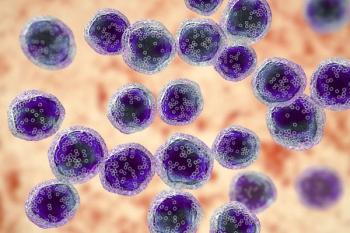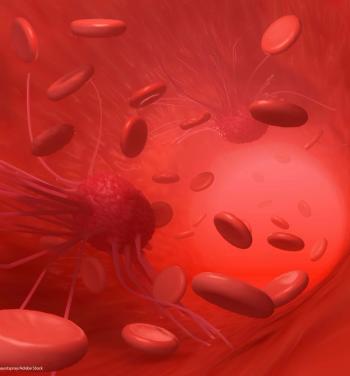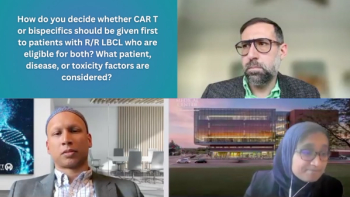
Oncology NEWS International
- Oncology NEWS International Vol 8 No 2
- Volume 8
- Issue 2
Longer Survival Observed With CHVP Plus Interferon in Elderly High-Risk Follicular Lymphoma Patients
LYON, France-The addition of interferon-alfa-2b (IFN, Intron A) to the usual CHVP regimen (cyclophosphamide, doxorubicin, teniposide, prednisone) extends survival in elderly patients with high-risk follicular lymphoma, Dr. Bertrand Coiffier said at the ASH meeting.
LYON, France-The addition of interferon-alfa-2b (IFN, Intron A) to the usual CHVP regimen (cyclophosphamide, doxorubicin, teniposide, prednisone) extends survival in elderly patients with high-risk follicular lymphoma, Dr. Bertrand Coiffier said at the ASH meeting.
He reported results of a randomized GELA study (Groupe d’Etude des Lymphomes de l’Adulte) showing longer survival with CHVP plus interferon than with fludarabine (Fludara). “The rationale for the study,” he said, “was to try to increase the efficacy of the chemotherapy by adding interferon.”
Randomization
The study randomized 131 follicular lymphoma patients (all grades) to receive 12 courses of CHVP plus 18 months of interferon or 12 courses of fludarabine in 18 months.
Patients were age 60 to 75 years of age, had follicular lymphoma with a high tumor burden as defined according to the REAL (Revised European American Lymphoma Study Group) classification, and had at least one adverse prognostic factor (77% of patients had more than one poor prognosis factor).
Response Rates and Survival
The response to treatment at 6 months showed a significant difference in favor of CHVP plus interferon (71% vs 58% in the fludarabine arm). At 6 months, 21% of the patients receiving combination therapy had progressed vs 39% on the fludarabine arm.
At 18 months, 57% of CHVP/IFN patients had reached a complete or partial response vs 39% for fludarabine, and 36% had progressed vs 52% on fludarabine.
At median follow-up of 25 months, time to progression and survival were significantly shorter in the fludarabine arm than in the combination arm; 81% of patients receiving CHVP plus interferon were still alive at 2 years vs 59% on fludarabine.
Multivariate analysis revealed only two factors significantly associated with survival: treatment and the number of adverse criteria. Patients who had only one adverse prognostic factor had a very good survival, compared with those with three or more, Dr. Coiffier said.
The CHVP plus interferon regimen appeared to be more toxic: 22 patients stopped interferon, and 8 had a dose reduction because of adverse events, and 26% of CHVP/IFN patients had grade 3-4 neutropenia vs 5% of fludarabine patients. There was no dose-limiting thrombocytopenia.
“The interferon toxicity was more potent than had been described in the GELA 1986 study,” Dr. Coiffier said. But this could have been because the patients in that earlier study were younger. He said that 50% of patients on the current study continued treatment with no problems, and a few had their IFN dosage decreased.
The study confirms the use of CHVP plus interferon as standard treatment of elderly patients with high-risk follicular lymphoma, Dr. Coiffier concluded.
Articles in this issue
almost 27 years ago
Paclitaxel Plus Mitoxantrone for Poor-Prognosis Breast Canceralmost 27 years ago
Faslodex, Pure Antiestrogen, Studied in Tamoxifen-Resistant Breast Canceralmost 27 years ago
LHRH Agonist Plus Tamoxifen Improves Outcome in Young Metastatic Patientsalmost 27 years ago
Pros and Cons of Different Approaches to Chemoradiationalmost 27 years ago
Less Cardiotoxicity With Liposomal Doxorubicinalmost 27 years ago
Optimizing Docetaxel Tolerability in Anthracycline-Resistant Breast Canceralmost 27 years ago
Doxorubicin Appears to Change Natural History of HER-2+ Cancer’salmost 27 years ago
Tamoxifen After Surgery/RT Decreases Local Recurrence Risk in DCIS PatientsNewsletter
Stay up to date on recent advances in the multidisciplinary approach to cancer.



















































































